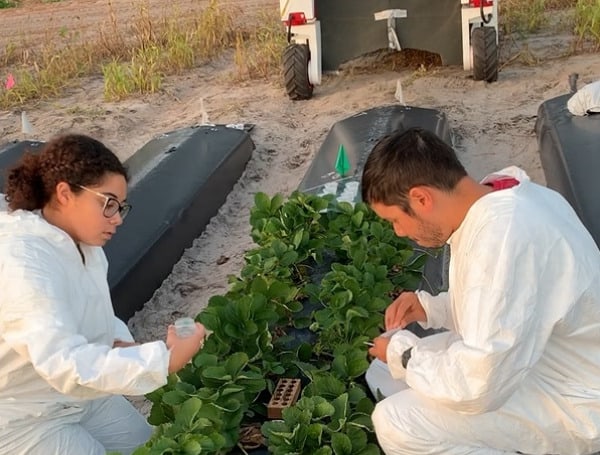For a few years, University of Florida plant pathologist Natalia Peres has used an ultraviolet light system to thwart strawberry pathogens. Peres eve
For a few years, University of Florida plant pathologist Natalia Peres has used an ultraviolet light system to thwart strawberry pathogens. Peres even published a study this year that showed the system helps control powdery mildew.
Two fellow researchers with the UF Institute of Food and Agricultural Sciences have now used the same robotic UVC applicator to show that it works well to slow the spread of one strawberry pest, but not a second.
The three scientists, Peres and others at UF/IFAS are trying to tamp down pests and diseases for Florida’s $300 million-a-year strawberry industry.
Joseph Dean Montemayor – working under the supervision of entomology assistant professor Sriyanka Lahiri — focused on whether a system that uses UVC radiation can control mites and thrips.
They also studied whether UVC would interfere with biological control efforts of mites or thrips, both of which cause significant fruit loss if left untreated. In this case, they examined whether radiation would kill the predatory mites that eat these pest mites and thrips infesting strawberries.
Results indicate that the eggs of the predatory mites, just like those of spider mites, die after irradiation with UVC. This indicates that biological control through predatory mites can be most effective only after a strawberry crop is treated with UVC radiation rather than irradiating strawberries while the predatory mites are present in the field simultaneously.

Credit: Courtesy, Sriyanka Lahiri, UF/IFAS.
The research, part of Montemayor’s recently completed master’s thesis, shows that the system works well to control spider mite eggs but not chilli thrips. Specifically, the dosage of UVC radiation applied to strawberry plants in the field mostly suppressed spider mite eggs from hatching but did not deter chilli thrips infestations, said Lahiri, a faculty member at the Gulf Coast Research and Education Center (GCREC).
The study’s results will become part of an integrated pest management system to help strawberry growers.
“This information is useful to the strawberry growers of Florida, who have to constantly battle with chilli thrips and spider mites,” Lahiri said. “Also, this information is relevant to strawberry
growers across the world, industry partners and the small-fruit crops research and Extension community.”
Montemayor, who will graduate in August with a master’s degree in entomology and nematology from the UF/IFAS College of Agricultural and Life Sciences, planted new UF/IFAS strawberries including ‘Florida Brilliance,’ ‘Florida Radiance’ and ‘Sweet Sensation’ in fields at GCREC.
For his thesis, Montemayor also studied the potential impact of UVC radiation on predatory mites. Strawberry growers currently use a mite known as Phytoseiulus persimilis to keep the twospotted spider mite from harming their fruit, Lahiri said. Montemayor exposed this adult predatory mite to the same dose of UVC that was effective in suppressing spider mite eggs.
He found that P. persimilis, remained unaffected and was able to actively feed on spider mite eggs.
“Thrips and spider mites are the most economically damaging species affecting strawberry production in Florida,” Lahiri said. “Even though there is overwhelming reliance on the use of synthetic insecticides and miticides to manage these pests, biological control agents such as predatory mites can be effective in integrated pest management in strawberry. Another way is to use UVC irradiation, applied after sunset, to manage these entomological pests along with strawberry pathogens. Both these pest management tools can be used complementary to each other.”
Lahiri, Peres and vegetable entomologist Hugh Smith, all faculty members at the GCREC, served as members of Montemayor’s master’s thesis committee.
Support journalism by clicking here to our gofundme or sign up for our free newsletter by clicking here
Android Users, Click Here To Download The Free Press App And Never Miss A Story. It’s Free And Coming To Apple Users Soon.

COMMENTS